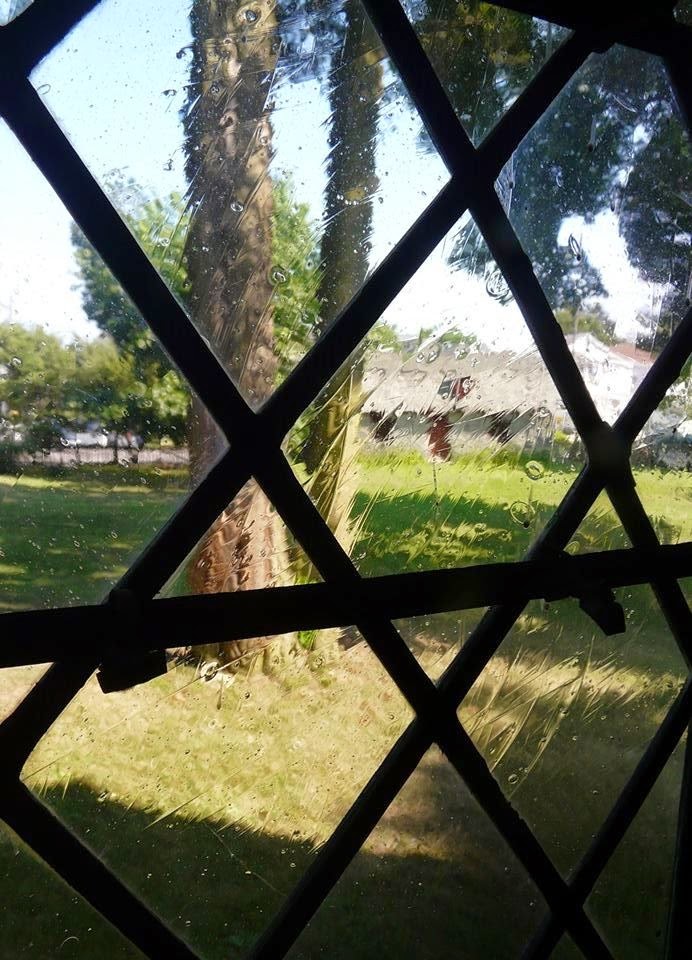The Hempsted House has been grappling with the best way to talk
about Adam Jackson, enslaved worker, and Joshua Hempsted, slaveholder. We have
Joshua’s diary, which mostly provides a record of Adam’s work, but we have nothing
from Adam’s perspective.
The idea of
one enslaved person living in a house with a family is a very different concept
than the more familiar concept of plantation slavery, where large numbers of
enslaved people lived in separate quarters and often had very little
interaction with white slaveholders and their families. This concept of Adam
and Joshua sharing a roof, sharing similar chores, and sharing the task of
training Joshua’s grandsons for their futures can lead to confusion about the roles
and realities of colonial slavery. As there were 200 years of slavery before
the cotton loom, the Hempsted House can help visitors learn more about Northern
slavery.
We know that
within three generations of Hempsteds there were at least nine slaveholders in
the family. Other enslaved workers owned by Hempsted family members included
Dinah, a middle-aged worker, who ran away from the house in 1803, and the
famous Venture Smith, who purchased freedom for himself and his family and became
a successful landholder in CT.
We have some amazing stories of freedom,
perseverance, and opportunities lost and gained. How do we make these stories
come alive? What’s the best way to tell these stories? Those are the central
questions 12 advisors grappled with June 20-21 during a symposium funded by
Connecticut Humanities at the Hempsted Houses in New London.
The
panelists were all chosen for the work they have done in the field of Northern
slavery, either through research, artistic expression, or museum and classroom interpretation.
They debated how the site should be shared with visitors, best avenues for
special programs and events, proposals for a school curriculum, and how to
incorporate the enslavement of Native Americans into the stories told at the
site. Their suggestions listed below give us much to work on!
- Go global. Share that slavery was a global business and show places throughout the globe where enslaved people were sent to work for others. Convey that slavery was a global system of incredible cruelty and places in North America, like New London, represent just a very small piece of this global story.
- Present a typical day in the life of the enslaved at the Hempsted House. This will help share the realities of slavery in the colonial north. Show some of the places “disobedient slaves” might be sent if they became known for insubordination.
- Focus on the role of Native Americans and African Americans in the maritime world. New London is a port city and it is important to show what many people of color were doing at sea. Historically, New London was approximately 6-10% people of color, while at sea approximately 20% were non-white. At sea, society was often merit based and there was a very different sense of power.
- Move away from documents written primarily by white men by using Museum Theater to give voice to the enslaved. Theater provides an opportunity to show how someone whose voice wasn’t recorded could have reacted to and resisted the system of slavery. (For example, Joshua’s diary provides a list of everything Adam Jackson breaks while working for him.) Reader’s Theater can be a great way to get school groups involved in these discussions.\
- Create a visitor experience that focuses on a specific year in the life of the Hempsted House. Focus on different historic events that happened during that year. Every few years, the visitor experience can be changed by moving to a new year and focusing on different historic events. This allows visitors to participate in living history, as seen through the eyes of the people associated with the Hempsted House.
We are grateful
for the support of Connecticut Humanities and the work of our panelists:
Dr. Allegra di Bonaventura, author of
the book that has brought Joshua Hempsted and Adam Jackson to life in For Adam’s Sake: A Family Saga in Colonial
New England, and Assistant Dean of the Graduate School of Arts &
Sciences at Yale University.
Dr. David Canton, Associate Professor
of History at Connecticut College. Dr.
Canton also serves on our community advisory panel for the reinterpretation of
the Joshua Hempsted House.
Tammy Denease, an
accomplished Connecticut performing
artist/storyteller.
Dr.
Paul J. Grant-Costa, Executive Editor of The Yale Indian Papers
Project.
Richard Josey,
Manager of Programs for Historic Sites, Minnesota Historical Society, formerly
spent 12 years working at Colonial Williamsburg Foundation.
Robert Kiihne,
Exhibit Developer, working on the Hempsted House reinterpretation.
Michael
A. Lord, Director, Education, Historic Hudson Valley,
Philipsburg Manor.
Dr. Jason Mancini, Senior Researcher at the Mashantucket Pequot Museum
and Research Center.
Paulie
Reed, 4th and 5th Grade
Teacher at the Regional Multicultural Magnet School, New London.
Dr. David A. Spatz,
Assistant Director of The Gilder Lehrman Center for the Study of Slavery,
Resistance, and Abolition at Yale University.
Dr. Wendy Warren, Assistant Professor
of History at Princeton University.
Sheryl Hack, Barb Nagy, Aileen Novick –
CTL Staff
- Aileen Novick

